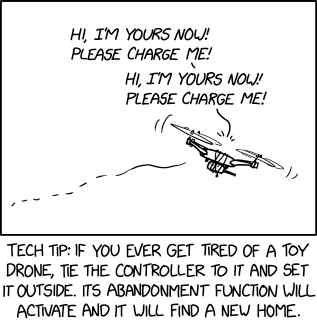Abandonment Function

Remember to only adopt domesticated drones that specifically request it. It's illegal to collect wild ones under the Migratory Drone Treaty Act.

Remember to only adopt domesticated drones that specifically request it. It's illegal to collect wild ones under the Migratory Drone Treaty Act.
This is another one of Randall's Tips, this time a Tech Tip.
Pet abandonment is a situation of concern among biological pets, and is part of the reason there are animal rescue organizations providing for adoption in most regions. Since drones are automated, they can be programmed to have an automatic abandonment function.
In reality, this "abandonment function" is the norm that things left outside homes are often considered gifts for any passersby who would like them. Hence, following the instructions in the webcomic may result in one's drone disappearing for a new owner, but not for the reason depicted.
With the drone responsible for flying to find its own new owner, one can possibly imagine it becoming more and more "fervent" as its charge runs down, to prevent the accumulation of derelict drones in the streets.
Triggering abandonment based on extended close proximity to the device's own controller could produce issues such as accidental activation, or malicious activation by a party who could send the proximity signal from a great distance, possibly to many drones at once, via software defined radio. It is, however, more likely that being left consciously uncontrolled for an extended period is the actual trigger, with the attachment of the controller being more a direct courtesy to the next adoptive-owner, and/or preventing the loss of carrier signal that would instead activate whatever auto-homing (i.e. return-to-launch-point) behavior the more sophisticated drones may use if ever beyond their pre-programmed flight parameters.
The concept of there being "wild" vs "domesticated" drones rings again both of wildlife and pets, and of new intelligent software providing for drones acting on their own. In the latter case, protection for "wild" drones could imply many things about the role of artificial intelligence in society. Did we organize the wild drones to obey our laws, or are we protecting them in fear of being punished by their superior power? A foreign military drone could also be considered a wild drone.
But more likely Randall is imagining flocks of abandoned drones, fending for themselves, traveling distances as they survive off of seasonally-dependent charging resources. This is similar to the behavior of birds, which are protected (in the U.S.) by the real-world Migratory Bird Treaty Act of 1918. Aggressive flocks of drones was used in 1630: Quadcopter and drones has become a recurring theme on xkcd, where also training of drones as a pet has been the subject in 1881: Drone Training.
This idea of protecting drones is analogous to the anomaly that misbehaving drones have not been well tracked by law enforcement: https://observer.com/2020/01/drone-flock-mystery-baffling-authorities/ . If computer viruses continue to evolve, wild drones could indeed evolve too, as they are directed by software, but usually a human being or organization is considered to be somewhere at the helm (separately) of both computer viruses and drones.
The idea that a drone may choose of its own volition whether to find a new owner or join a wild flock is a little similar to the situation for abandoned pets.